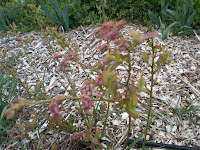I guess you have to be bit crazy to get excited about the first batch of canning for the season, but we do …every year! We started off the 2012 canning season with strawberry jam – 20 pints of it. We use the low sugar “Sure-Jell” kind, and pretty much follow the instruction verbatim. EXCEPT: we make the regular jam (NOT the freezer kind), – but then store the jam in the freezer.
 We like the taste and consistency of the regular low sugar jam, but the color and freshness that the freezer provides. We also do this for nectarine and peach jam – they all loose their color and flavor too fast if not frozen.
We like the taste and consistency of the regular low sugar jam, but the color and freshness that the freezer provides. We also do this for nectarine and peach jam – they all loose their color and flavor too fast if not frozen.Our second canning job were the peas this weekend. Between ourselves, our family and friends we ended up picking 24 buckets of peas, or 15 bushel. We never did finish picking the entire patch, we simply ran out of time and volunteers….but then the peas were supposed to be a cover crop anyhow, to get nitrogen into the soil. The pea pods were just a happy by-product. We canned 50 quarts of peas between Friday night and Saturday.






